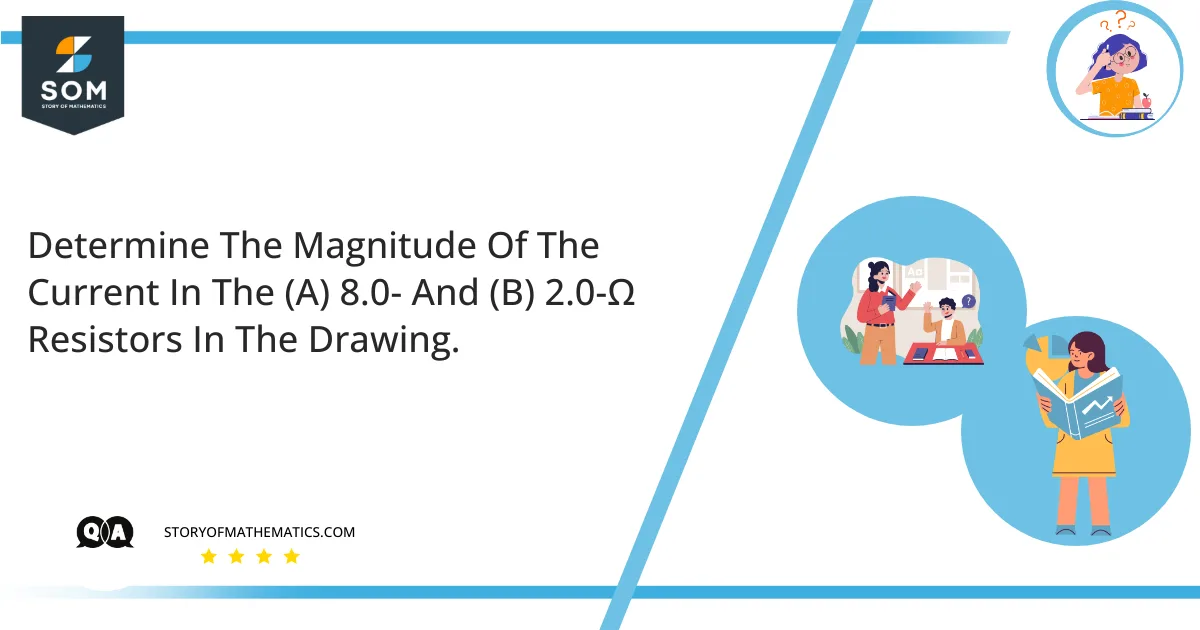
The main objective of this question is to find the direction and magnitude of the current in 0.2 ohm and 0.8 ohm resistors.
This question uses the concept of Kirchoff’s current law and Kirchhoff’s voltage law to find the direction and magnitude of current for the given circuit diagram. In Kirchoff’s current law, the current entering the node must be equal to the current leaving the node while in Kirchoff’s voltage law the overall sum of voltage is equal to zero.
Expert Answer
We are given with:
$ V_1 =4.0 v $
$ R_1=8.0 ohm$
$ V_2=12v$
$R_2=2.0 ohm $
We have to find the direction and magnitude of the current in the $8.0$ ohm and $2.0$ ohm resistor.
So, applying Kirchoff’s current law which is:
\[i_1 \space – \space i_2 \space – \space i_3 \]
\[4 \space – \space 8i_3 \space + \space 2i_2 \space = \space 0 \]
Now applying Kirchoff’s voltage law results in:
\[\space -2i_2 \space + \space 12 \space = \space 0 \]
Then:
\[2i_2 \space = \space 12\]
Dividing by $2$ will result in:
\[i_2 \space = \space 6 \space a \pm \]
Putting the value of $i_2$ results in:
\[4 \space – \space 8i_3 \space + \space 2 \space \times\ 6 \space = \space 0 \]
\[16 \space – \space 8i_3 \space = \space 0\]
\[8i_3 \space = \space 16 \]
\[i_3 \space = \space 2a \space \pm \]
So, putting the value of $i_3$ will result in:
\[i_1 \space = \space i_2 \space + \space i_3 \space = \space 8a \pm\]
Thus $i_1$ is equal to $8a$ \pm.
Numeric Answer
The current $i_1$ is $8a$ \pm while the current $i_2$ is $6a$ \pm and current $i_3$ is $2a$ \pm .
Example
In this question, you are required to find the direction and magnitude of the current in $10$ ohm and $4$ ohm resistors and the voltage $V_1$ is $4.0 v$ and the $V_2$ is $12v$.
We are given the following data:
$V_1 =4.0 v$.
$R_1=10.0 ohm$.
$V_2=12v$.
$R_2=4.0 ohm$.
In this question, we have to find the direction and magnitude of the current in the $10.0$ ohm and $4.0$ ohm resistor.
So, applying Kirchoff’s current law which is mathematically represented as:
\[i_1 \space – \space i_2 \space – \space i_3 \]
\[4 \space – \space 10i_3 \space + \space 2i_2 \space = \space 0 \]
Now applying Kirchoff’s voltage law which is mathematically represented as:
\[\space -4i_2 \space + \space 12 \space = \space 0 \]
Then:
\[4i_2 \space = \space 12\]
Dividing by 4 will result in:
\[i_2 \space = \space 3 \space a \pm \]
Putting the value of $i_2$ results in:
\[4 \space – \space 10i_3 \space + \space 2 \space \times\ 3 \space = \space 0 \]
\[10 \space – \space 8i_3 \space = \space 0\]
\[8i_3 \space = \space 10 \]
\[i_3 \space = \space 1.25a \space \pm \]
So, putting the value of $i_3$ will result in:
\[i_1 \space = \space i_2 \space + \space i_3 \space = \space 4.25a \pm\]
Hence, the current in the $10-ohm$ and $4-ohm$ resistor is $1.25-ohm$ and $3-ohm$, respectively.
